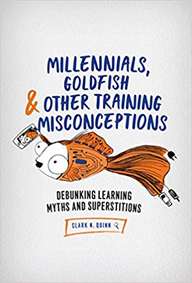- Home
- Articles
- Reviews
- About
- Who we are
- Write for us
- Contact us
About
- Archives
- Past Issues
- The eLearn Blog
Archives
| To leave a comment you must sign in. Please log in or create an ACM Account. Forgot your username or password? |
|
Create an ACM Account |

In writing his book Millennials, Goldfish & Other Training Misconceptions (ATD Press, 2018), Clark Quinn has delivered an incisive handbook that examines commonly held beliefs, myths, and misconceptions on many facets of learning. He methodically and skillfully dissects common and not-so-common claims, evaluating them in light of established theories of knowledge and learning, and provides insightful commentary on learning-based myths and misconceptions.
The author briefly introduces the premise of the book in the first two chapters, "The Myths that Hold Us Back" and "The Science of Learning." Quinn states, "If learning design is a field that aspires to be truly professional, mistaken beliefs can serve to undermine our credibility." He encourages the diligent and careful evaluation of any and all claims by a careful application of scientific rigor and research methodology.
The remaining chapters—"Learning Myths," "Learning Superstitions," and "Learning Misconceptions"—are a compilation of a number of specific claims that are logically presented by their appeal and their positive and negative implications. Quinn defines myths as untrue beliefs, superstitions as "prevalent practices that persist despite their lack of value," and misconceptions as controversial subjective interpretations of research. For the first two, he provides a brief examination of the supporting evidence and directives to evaluate and follow-up the original claim.
Analyzing one such claim: "People can be characterized by their relative proportion of left- and right-brain capabilities," Quinn cites the peer-reviewed research of Jared A. Nielsen and his colleagues who examined neuroimaging scans and "found lateralizations in some areas, but not consistently in one individual versus another." Their research led Quinn to conclude there was no definitive evidence for the aforementioned claim.
For misconceptions, the author presents the claim and the appeal, following it up with a counter argument and a reconciliation. One such topic the author examines deals with gamification in learning, a hot topic in today's learning circles. "Gamification is a valuable contribution to achieving learning outcomes," writes Quinn, who strikes a middle ground here, identifying "intrinsic interest" as the core component of successful gaming. He advocates finding such intrinsic interest in subject matter in the process of creating learning programs and, while pushing for the adoption of gamification principles, he cautions against "rewarding wrong behaviors."
Quinn's writing style makes the book accessible to all readers and, despite systematically questioning and debating each of the 37 claims presented in the book, he is not condescending to the reader. His critique is balanced and he relies on epistemological principles of scientific research to validate his position even when true experimental data may not be forthcoming. As he states in his chapter "The Science of Learning," "When experimental data aren't a sufficient basis for design, the next best step is to go to a theory that's relevant."
Each claim in the book is accompanied by a humorous cartoon, which wryly characterizes the topic being discussed. Toward the end of the book, Quinn also presents a synopsis of the claims covered in a tabular format for easier reference. These reference cards are an easy and valuable pull-out resource for trainers and practitioners in the field of education to use in their presentations and learning modules.
In today's fast-paced educational environment, Quinn's book is a relevant resource for the eLearning community. It speaks to the tried and tested practice of the scientific method-to empirically verify facts, and disregard superstitions and myths.
The book is best enjoyed in short reads, in no particular order. In our technology fueled era of learning, where a sound bite of information can spread with much authority across media, this book advocates a much needed reason to pause, reflect, and question many of the widespread beliefs and misconceptions about learning and teaching. It is a valuable read for teachers, students, trainers, and anyone else who is in any way vested in the field of learning and teaching.
Published by the Association for Talent Development (ATD), the title is available at ATD's website and other major booksellers.
Praveen Krishnamurti is currently the Director of Information Technology at the Marcus Center for the Performing Arts in Milwaukee, Wisconsin. He was formerly the Director of Digital Strategy at the Milwaukee Art Museum. With a 30-year background in leading information technology for non-profit organizations and corporations, his primary interest lies in the intersection of (digital) technology and learning. He lives in Milwaukee, Wisconsin, with his wife and their daughter.
Permission to make digital or hard copies of all or part of this work for personal or classroom use is granted without fee provided that copies are not made or distributed for profit or commercial advantage and that copies bear this notice and the full citation on the first page. Copyrights for components of this work owned by others than ACM must be honored. Abstracting with credit is permitted. To copy otherwise, or republish, to post on servers or to redistribute to lists, requires prior specific permission and/or a fee. Request permissions from [email protected].
2018 Copyright © ACM. 1535-394X/18/09-3281463
|
To leave a comment you must sign in. |
|
Create an ACM Account. |